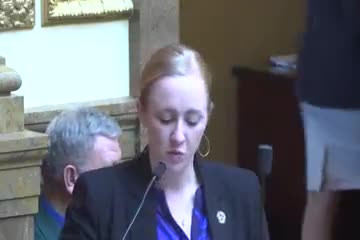Utah lawmakers approve transportation grants for high growth areas in Salt Lake County
February 23, 2024 | 2024 Utah Legislature, Utah Legislature, Utah Legislative Branch, Utah

This article was created by AI summarizing key points discussed. AI makes mistakes, so for full details and context, please refer to the video of the full meeting. Please report any errors so we can fix them. Report an error »

During the recent government meeting on February 23, 2024, Utah lawmakers took significant steps to address the pressing transportation needs in rapidly growing areas of the state. The highlight of the session was the passage of a bill aimed at enhancing public transit services in high-growth regions, particularly in the Southwest Corner of Salt Lake County, which has seen a surge in population but lacks adequate transit options.
The bill, known as HB 430, introduces a public transit innovation grant program designed to empower cities to collaborate and propose solutions tailored to their unique transit challenges. This initiative is particularly crucial for communities like South Jordan, Riverton, Herriman, and Bluffdale, which collectively represent a substantial portion of Salt Lake County's population but have minimal public transit infrastructure. For instance, many of these cities currently have no bus lines, leaving residents without reliable transportation options.
Key components of the bill include directing the Utah Transit Authority (UTA) to allocate 10% of certain tax revenues towards these innovation grants. This funding will allow cities to demonstrate ridership needs and develop proposals for capital improvements, such as new bus stops or service expansions. The bill also establishes a reporting mechanism to evaluate transit utilization rates every two years, ensuring accountability and responsiveness to community needs.
While the bill received strong support from several representatives who emphasized the urgent need for improved transit services, some concerns were raised regarding UTA's existing resource limitations. Critics cautioned that diverting funds to new initiatives might dilute efforts to strengthen the core transit system. However, supporters argued that this bill represents a necessary first step towards addressing long-standing transit gaps in underserved areas.
As the bill moves to the Senate for consideration, it signals a proactive approach to transportation planning in Utah, aiming to create a more equitable and accessible transit system for all residents. The discussions reflect a growing recognition of the importance of adapting transit services to meet the demands of a changing population landscape, ultimately enhancing the quality of life for Utahns in high-growth areas.
The bill, known as HB 430, introduces a public transit innovation grant program designed to empower cities to collaborate and propose solutions tailored to their unique transit challenges. This initiative is particularly crucial for communities like South Jordan, Riverton, Herriman, and Bluffdale, which collectively represent a substantial portion of Salt Lake County's population but have minimal public transit infrastructure. For instance, many of these cities currently have no bus lines, leaving residents without reliable transportation options.
Key components of the bill include directing the Utah Transit Authority (UTA) to allocate 10% of certain tax revenues towards these innovation grants. This funding will allow cities to demonstrate ridership needs and develop proposals for capital improvements, such as new bus stops or service expansions. The bill also establishes a reporting mechanism to evaluate transit utilization rates every two years, ensuring accountability and responsiveness to community needs.
While the bill received strong support from several representatives who emphasized the urgent need for improved transit services, some concerns were raised regarding UTA's existing resource limitations. Critics cautioned that diverting funds to new initiatives might dilute efforts to strengthen the core transit system. However, supporters argued that this bill represents a necessary first step towards addressing long-standing transit gaps in underserved areas.
As the bill moves to the Senate for consideration, it signals a proactive approach to transportation planning in Utah, aiming to create a more equitable and accessible transit system for all residents. The discussions reflect a growing recognition of the importance of adapting transit services to meet the demands of a changing population landscape, ultimately enhancing the quality of life for Utahns in high-growth areas.
View full meeting
This article is based on a recent meeting—watch the full video and explore the complete transcript for deeper insights into the discussion.
View full meeting

